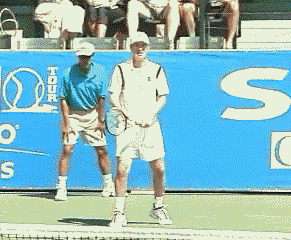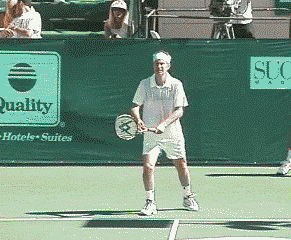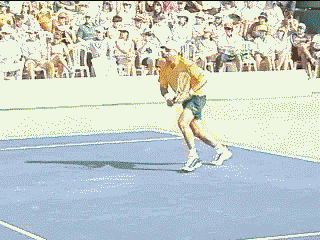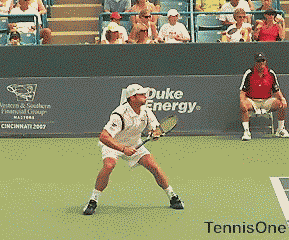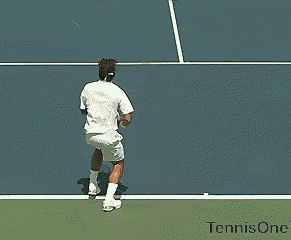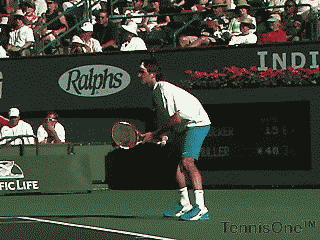|
TennisOne Lessons Adding and Borrowing Pace Jim McLennan Over the years I have written about the evolution of the game, and the changes wrought from the technological advancements in equipment, training, and coaching. Certainly the game is played faster, with more spin, power, and movement than at any time before. One can only wonder how the game will look 10 years from today. But if we were to contrast the modern game with one from an earlier, perhaps more aptly called “wooden age,” the contrast appears most striking in how the ball was and is met. The wooden age was more about shift of weight, hitting carefully through the ball, and in many instances, using the incoming pace, borrowing that power as it were. Whereas the modern game is more about vigorous rotational swings at the ball, less shifting of weight into and or through the ball, and in nearly every instance adding pace to the incoming ball. But to my mind, in the game as played today, there are specific occasions when borrowing pace makes perfect sense, and others when adding pace rules the day. As ever, the devil lies in the details. In this case making the correct decision to either add or borrow pace, and to know when as well as where. When it comes to borrowing pace, take a page from one of the all time greats, John McEnroe, who still plays highly competitive tennis as he enters his fifth decade. Mac can play any shot, from any position, deftly cutting, blocking, chipping, or hitting, but always with an eye to using the incoming pace, like a martial artist who redirects the force of an incoming blow, Mac was still beating many of our ATP stars in recent World Team Tennis events. Yes he was a genius at court position, and that may have made up for his glaring lack of power, but to look closely at his technique, the strokes were always surprisingly short, the racquet moved slowly into the ball, the hit was solid, and said another way he borrowed nearly all of the incoming pace. In the following two sequences we see him simply and easily block the return of serve, seemingly without effort, but with a sure tactical eye that neutralized the offense of the incoming ball. And on closer inspection, he turns ever so slightly to prepare, places the racquet at the height of the incoming ball, and squares his racquet face at impact. Note particularly how his upper arm (humerus) appears to hang, the elbow does not fly up back or away, but remains more or less at his side. The simplicity of this stroke speaks volumes about his 78 ATP doubles titles, at one point the best doubles team in the world was simply John McEnroe and any partner.
Extending this analogy to the superb volleyers of days gone by, Patrick Rafter and Stefan Edberg come to mind. They were also some of the best returners because the return, like the volley, borrows pace, the stroke is short, and the collision is more about the incoming momentum rather than racquet speed. This mind set, if you will, lends itself particularly well to returning serve. We will revisit this concept when assembling these elements into your game.
Note as Rafter closes to the volley, he positions the racquet more or less behind the incoming ball, the strings face the ball (or net if that analogy works better for you) but the hit is not about rotation, rather it is about moving to and through the ball. Volleyers are known (as well as advised) to volley with their feet, and this is certainly the case here. And whereas the weight shift model is used to add firmness to a borrowed stroke, in this case Rafter is trying to get as close to the net as possible for increased angle (if he chooses), or to limit the opponents time to retrieve the shot. But in any event, the technique is not one of rotation but rather one of linear movement with the racquet face and body into and through the ball. The modern game, as Nick Bollitieri described at a recent USPTA conference, is now about racquet speed produced by powerful rotational movements and whipping hits. Modern players are able (and indeed determined) to add pace to nearly all incoming balls. The rallies are faster and more furious than I can believe. When sitting courtside, I forever marvel at how these superbly trained athletes are able to appear unhurried as the ball hurtles back and forth across the net. But again, it's about powerful rotational drives adding pace to the incoming ball. Perhaps this explains why so few of the modern players display real volleying prowess, not because the ball is so darn fast, but because they have spent so little time mastering the art of borrowing pace. And in the following two examples we can see both Andy and Roger whip the racquet through the ball, adding pace and spin, nothing borrowed from this account.
Contrasting the simplicity of McEnroe or the crisp forward movement of Rafter, in the two examples above, Andy and Roger wind up with significant shoulder turn away from the ball, followed by a vigorous acceleration of the racquet as they turn back toward the net. Roddick is more emphatic about lifting or cocking his elbow at the start of his wicked drive, Roger’s, as we would expect, is somewhat simpler. But in both cases the boys are swinging freely at the ball. In neither case are they borrowing pace. I would suspect, however, that the Federer simplicity lends itself to greater consistency on return of serve (as is the case) and greater fluency at the net (ditto). Adding and borrowing, rotational whip versus weight shift -- this comparison is not meant to explain the entire game, nor could it really, but it may shed some light into areas of the game where one or the other would really be the stroke of choice. To my eye, players who routinely borrow pace tend to return and volley fairly well, but rarely crack the ball on a groundstroke winner (the author). Others who routinely knock the cover off the ball rarely excel at half volleys, returns of big serves, or volleying moxie. But if you want to play a total game, where you can add and borrow, speed up or slow down the ball, and play from the backcourt, the midcourt and the net, it will be important to master both skills. Would Roddick be a better player (even though he continues to excel in Davis Cup and has now recorded a win over Federer) were he able to block and borrow pace on returns and at the net? Absolutely. In fact, if you revisit the upward cocking of his elbow as he starts his forehand preparation, something similar may occur when he returns serve, and Tennis Magazine published some time back that Andy’s percentage returning serve has declined in each of the past five years. To take this elbow analogy one step further, it may also explain his discomfort around the net, for to my eye his backhand volley has looked far more proficient than the one on the forehand wing.
Would McEnroe have been a better player had he created more heat on his ground strokes, perhaps most acutely, avoided his heart breaking French Open final loss to Ivan Lendl? Again absolutely. Mac never really cracked the ball, and I think he may have placed more emphasis on accuracy and court position than Lendl/Arias/Becker style forehands. I suspect, however, had his career blossomed during the modern era, Mac would have found a way to add more pace, that however is just a guess. And if he had built a bigger forehand, it would have been in the Federer model. But for you and I the question can and should be asked. Do you practice borrowing pace with simple strokes when returning serve or volleying? If yes, then great, if no, then get to work. And do you practice adding pace with longer rotational strokes when the court is open? If yes, then great and again, if no, then get to work. Tennis is such a great game, with so much for us to learn at every stage. Quoting Dennis Waitley, “When you’re green your growing, when ripe you fall off the tree.” Here is to green and growing. Your comments are welcome. Let us know what you think about Jim McLennan's article by emailing us here at TennisOne.
|
||||||||||||||
